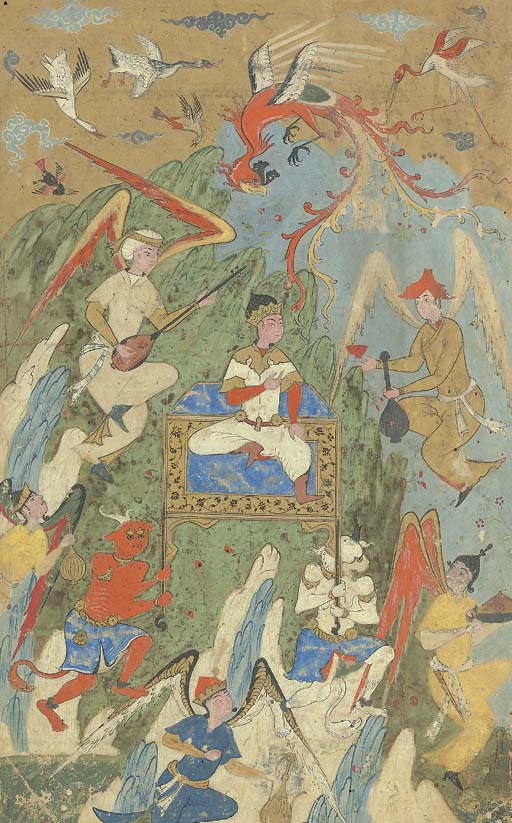

In a wonderfully realistic Persian bath (Iran, 1556-65)
Source: http://instruct1.cit.cornell.edu/Courses/nes257/bath.html
(downloaded Nov. 1999)
"Bath Scene from the Haft Awrang of Jami. Iran, Mid-16th Century (1556-65) 46. 12 FOL. 59. Freer Gallery of Art in Washington, D. C."

A very Persianized Mughal fantasy from the Shah-nama
Source: http://www.christies.com/LotFinder/search/LotDetail.asp?sid=&intObjectID=4457060&SE=CMWCAT03+358462+1081136515+&QR=M+1+64+Aqc0000900+348668++Aqc0000900+&entry=india&SU=1&RQ=True&AN=65
(downloaded Mar. 2005)
"A Folio from a Dispersed Shahnama Manuscript: A Royal Figure Surrounded by Celestial Musicians. India, Mughal, late 16th Century. Opaque watercolor on paper highlighed with gold, depicting a crowned figure at center supported by two demon figures and surrounded by winged celestials with cranes and a phoenix flying above, set against a mountain backdrop; the reverse with four columns of nastaliq inscriptions. Folio: 12½ x 8½ in. (31.7 x 21.6 cm.)."

The same Persian themes and styles extended into Turkish painting as well
Source: http://search.sothebys.com/jsps/live/lot/LotDetail.jsp?lot_id=4DV8W
(downloaded Mar. 2005)
"THE BATTLE BETWEEN THE SASANIAN KING KHUSRAU PARVIS AND BAHRAM CHUBINEH, ILLUMINATED LEAF FROM THE SHAHNAMA OF FIRDAWSI, TURKISH, 16TH CENTURY. Miniature 20 by 19cm. leaf 23.5 by 20cm.
DESCRIPTION: gouache heightened with gold on paper, text in four columns of nasta'liq script above and below miniature and 25 on the verso, miniature mounted with leaf from the same text.
CATALOGUE NOTE: This miniature is closely comparable to two leaves from an unidentified manuscript in the late Dr. Edwin Binney's collection. The miniatures exhibit a similarly crowded field of horses and warriors in a mountain scene. Abstracted rocks and trees in the left of the foreground break through into the margin, as do the army's pennants at the top of the scene. Although the Binney miniatures were catalogued as Persian in 1966, the golden sky and grouping of the army suggest a Turkish origin and the two miniatures were reassessed as Turkish and dated to 1580 in the Binney catalogue. It has been suggested that Turkish artists working on the manuscript from which these miniatures originated were working in the Tabriz style, as did those Turkish artists employed on the Houghton Shahnama (Binney 1979, cat 21a&b, p.44-46). It is likely that the current miniature is a product of the same tradition."
== Indian Routes index == Indian Routes sitemap == Glossary == FWP's main page ==